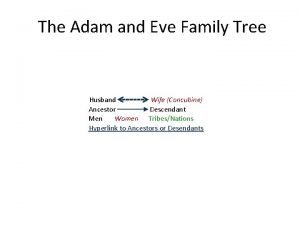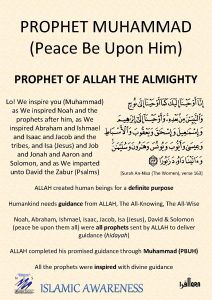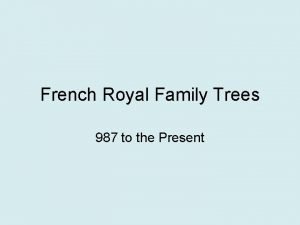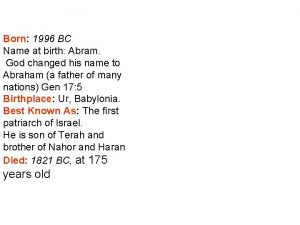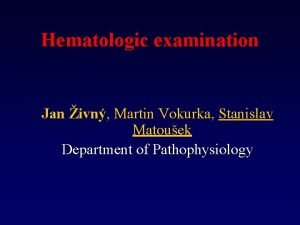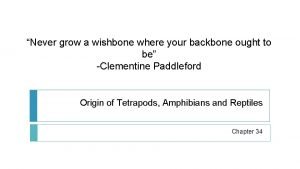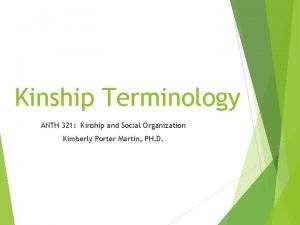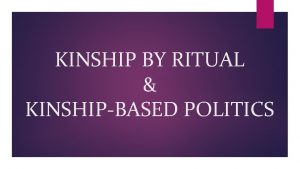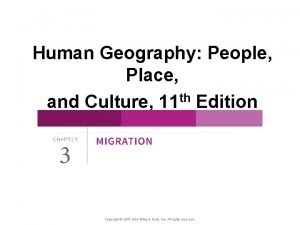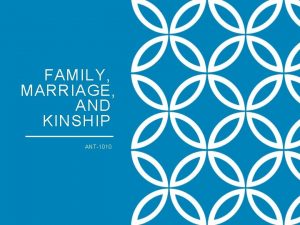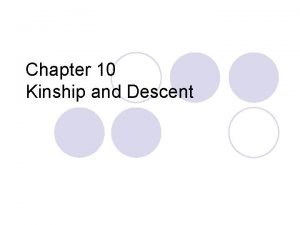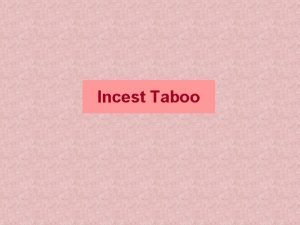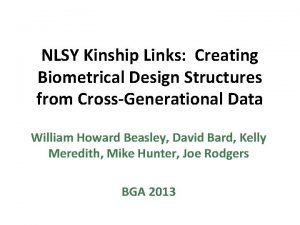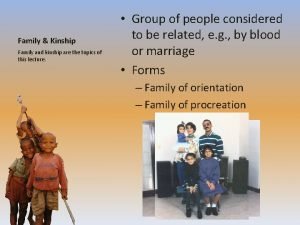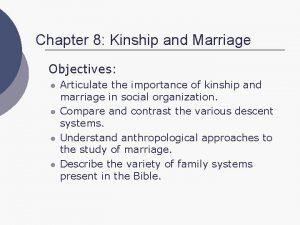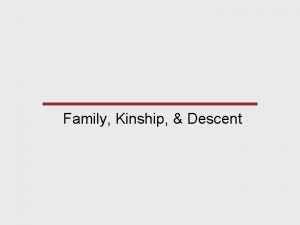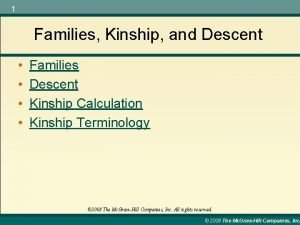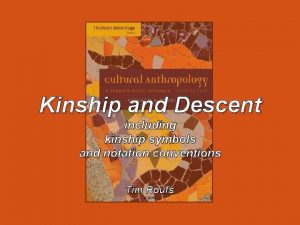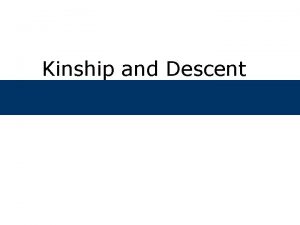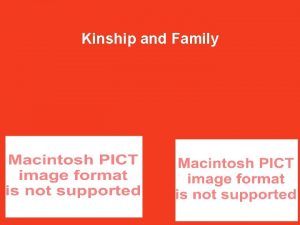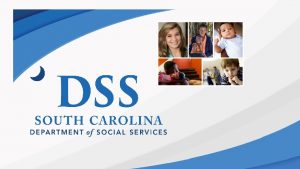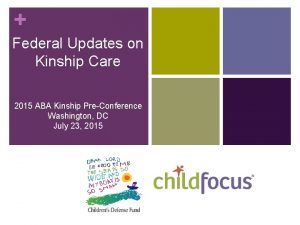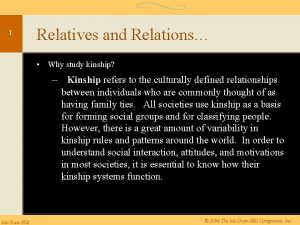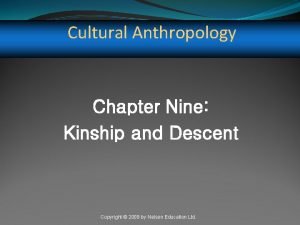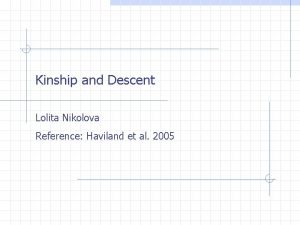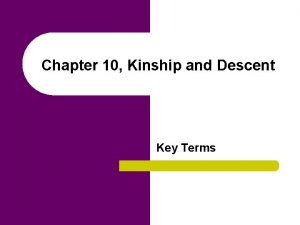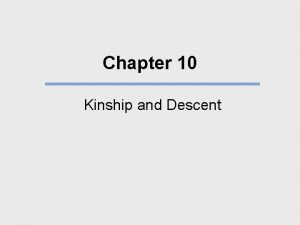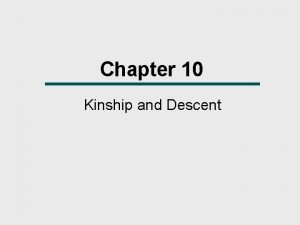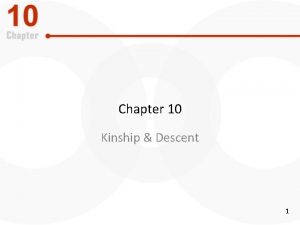Family Kinship Descent Lineage Group of kin whose























- Slides: 23

Family, Kinship, & Descent

Lineage • Group of kin whose members trace descent from a known or demonstrated common apical ancestor. • • E. g. , in one biblical genealogy, Jesus is in David’s lineage (an apical ancestor) through Joseph. Segmentary lineages: organized in a hierarchical structure, ranked according to the number of generations they encompass. Bedouin saying: "Me and my brothers against my cousins, me and my cousins against the world. "

Segmentary Lineage

Patrilineage • • Descent is traced through male lineage. Inheritance moves from father to son, as does succession to office. A man’s position as father and husband is the most important source of male authority. Example: Nuer of Sudan.

Kinship Diagram of Patrilineal Descent

Matrilineage • • • Descent is traced through the female line. Children belong to the mother’s descent group. Inheritance from mother to daughter. The inclusion of a husband in the household is less important. Women usually have higher status. Example: Hopi.

Kinship Diagram of Matrilineal Descent

Matrilineal and Patrilineal Descent

Clan • • Unilineal kinship group whose members believe they are descended from a common or apical ancestor but who can’t trace the link through known relatives. When a clan’s apical ancestor is nonhuman, it is called a totem.

Double Descent • • • Tracing descent through both matrilineal and patrilineal links. Double descent systems occur in only 5% of the world’s cultures. In these societies, a person belongs both to the father’s group and to the mother’s group, but the descent groups operate in different areas of life.

Parallel Descent • • • Kinship principle in which descent and inheritance follow gender-linked lines so that men consider themselves descended from their fathers and women from their mothers. Includes inheritance from paternal aunts to brother’s daughter and from maternal uncle to sister’s son. Creates strong gender identity and solidarity.

Cognatic Descent • Bilateral • System under which both maternal and paternal lines are used in reckoning descent and inheritance. • Common among foragers and in Western societies. • Kin terms are the same for maternal and paternal lines (e. g. , mother’s sister and father’s sister are called the same term).

Bilateral Descent A Kindred. A group of people, traced through bilateral descent, related to the brother and the sister shown at the bottom row, center.

Cognatic Descent • Ambilineal • A form of bilateral descent in which an individual may choose to affiliate with either the father’s or mother's descent group. • Membership is fluid as people can change their descent group membership. • With unilineal descent, membership is ascribed, but for ambilineal descent, membership is achieved.

Kinship Classification System • • • The emic system of kinship terms and the rules for using these terms. Every kinship classification system classes some relatives together and differentiates them from other relatives. Some systems have a small number of kinship terms, others have a different term for almost every relative.

Principles of Classifying Kin • • Generation Relative age Lineality vs. Collaterality Gender Consanguineal vs. Affinal kin Fictive kin Sex of linking relative Side of the family

Kinship Calculation • • Kinship calculation is any systemic method for reckoning kin relations. Genealogical Kin Types and Kin Terms • Kin type refers to the degree of actual genealogical relatedness. E. g. father’s brother. • Kin terms are culture-specific labels given to different kinds of relatives. E. g. s, “uncle”, “tío”.

Lineal (Eskimo) Terminology • Distinguishes 3 kinds of kin based on generation and gender and the nuclear family: • Consanguine: • • and affinal (through marriage) Most common system in Europe, Asia, and Western societies. • • Lineal (direct ancestors and descendants) Collateral (all other biologically related kin; e. g. siblings, nephews)

Lineal (Eskimo) Terminology

Irish-speaking Gaeltachtaí

Irish Kinship Quiz According to the Irish Kinship reading, which one of the following is primary in determining kinship relationships in terms of “uncle, ” “aunt, ” “nephew, ” “neice”, ’ and “blood relative” (col gaolta)? A. B. C. D. E. Relative age and generation Lineality Sex of linking relative Side of the family Consanguinality and affinality

Irish Kin Terminology • • Irish terms mirror those in English, but aintin (aunt), uncail (uncle), nia (nephew), neacht (niece), and col gaolta (cousin) have more inclusive meanings. Aintin, uncail, nia, and neacht refer to any relative whose age is of a great distance from the child or older person.

Irish Kin Terminology • • Col gaolta (“blood relative”) is used for all relatives in your generation or those near your age. Mo mhuintir (“my people”) is used for relatives people believe they are related too, but do not have enough information to determine how.
 Tracing family descent through mothers rather than fathers
Tracing family descent through mothers rather than fathers How did queen elizabeth 1 die
How did queen elizabeth 1 die Eva and adam family tree
Eva and adam family tree Hazrat ibrahim family tree
Hazrat ibrahim family tree Queen charlotte family tree
Queen charlotte family tree Adam to abraham family tree
Adam to abraham family tree Samuel lineage
Samuel lineage Sferocytosis
Sferocytosis Matei zaharia spark
Matei zaharia spark Rdd lineage
Rdd lineage Spark data lineage
Spark data lineage Synapsids
Synapsids Kinship terminology
Kinship terminology Kinship
Kinship What is kinship
What is kinship Kinship links definition ap human geography
Kinship links definition ap human geography Kinship systems
Kinship systems Hawaiian kinship system
Hawaiian kinship system Hawaiian kinship system
Hawaiian kinship system Biological kinship
Biological kinship Kinship links definition
Kinship links definition Kinship diagram symbols
Kinship diagram symbols Cross vs parallel cousins
Cross vs parallel cousins Aima slides
Aima slides


